Causal Agent:
Fungi (Choanephrora Cucurbitarum)
| Characteristic Symptoms: | |
 |
Affected flowers, pedicels (flower stalks), and immature fruit become water-soaked, and a soft wet rot develops. The fruit resembles a pincushion with numerous small, black-headed pins stuck in it. Flowers are covered with white then purplish black fungal growth. |
 |
An entire fruit can rot in a 24- to 48-hour period. |
| Conditions for Disease Development: | |
 |
Development of wet rot is favored by high relative humidity and excessive rainfall. |
 |
The fungus survives from season to season in crop debris and is spread to new flowers by insects, splashing water, or wind. |
 |
Infection most commonly occurs on flowers, although the fungi can also infect through wounds on the fruit. Infected flowers are soft, rotted and quickly become covered with first white then purplish black fungal growth. In female flowers, the infection progresses into the fruit and results in soft water rot of the blossom end. |
| Management and Control: | |
 |
Practice crop rotation. |
 |
Avoid overhead irrigation. |
 |
Space plants to provide adequate air movement in the field to quickly dry flowers and fruit. |
 |
Raised plant beds and plastic mulch may be of help to limit fruit contact with moist soil and reduce moisture in the lower plant canopy. |
 |
Spray copper-based fungicides. |
| References: | |
| http://www.aces.edu/pubs/docs/A/ANR-0874/ANR-0874.pdf | |
| http://plantpath.ifas.ufl.edu/media/plantpathifasufledu/factsheets/pp0011.pdf | |
| http://www.extension.umn.edu/garden/yard-garden/vegetables/diseases-of-cucurbits/choanephora-rot/ | |
To view other diseases, click here.
Need more help? Ask the Doctor.








